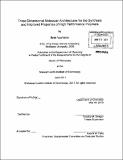| dc.contributor.advisor | Timothy M. Swager. | en_US |
| dc.contributor.author | VanVeller, Brett (Brett Steven) | en_US |
| dc.contributor.other | Massachusetts Institute of Technology. Dept. of Chemistry. | en_US |
| dc.date.accessioned | 2011-08-30T15:40:10Z | |
| dc.date.available | 2011-08-30T15:40:10Z | |
| dc.date.copyright | 2011 | en_US |
| dc.date.issued | 2011 | en_US |
| dc.identifier.uri | http://hdl.handle.net/1721.1/65478 | |
| dc.description | Thesis (Ph. D.)--Massachusetts Institute of Technology, Dept. of Chemistry, 2011. | en_US |
| dc.description | Vita. Cataloged from PDF version of thesis. | en_US |
| dc.description | Includes bibliographical references. | en_US |
| dc.description.abstract | Conjugated polymers have found various uses in optoelectronic applications, including chemical sensors, light-emitting diodes, and photovoltaic materials. In this thesis, we investigate the effect of having a molecular architecture that is both rigid and three-dimensional might play in the synthesis and performance of conjugated polymers. We discuss the efficient synthesis of a hydrophilic monomer bearing a threedimensional noncompliant array of hydroxyl groups that prevents water-driven excimer features of hydrophobic poly(p-phenylene ethynylene) backbones. We also use the detection of 3-nitrotyrosine as a probe to learn more about its physical state in solution. We further utilize the monomer above in a biocompatible post-polymerization functionalization reaction, taking advantage of the polymer's structural motif for the controllable attachment of biotin. The utility of this method is demonstrated for a model biosensor that responds to streptavidin. Finally, we discuss how rigid molecular architectures can be harnessed to bring two reacting groups together for the annulation of various [pi]-systems. The optical effects of the transformation are both notable and predictable, and the molecules have potential as monomers for conjugated polymer application in high performance organic light emitting diodes and photovoltaic devices. | en_US |
| dc.description.statementofresponsibility | by Brett VanVeller. | en_US |
| dc.format.extent | 148 p. | en_US |
| dc.language.iso | eng | en_US |
| dc.publisher | Massachusetts Institute of Technology | en_US |
| dc.rights | M.I.T. theses are protected by
copyright. They may be viewed from this source for any purpose, but
reproduction or distribution in any format is prohibited without written
permission. See provided URL for inquiries about permission. | en_US |
| dc.rights.uri | http://dspace.mit.edu/handle/1721.1/7582 | en_US |
| dc.subject | Chemistry. | en_US |
| dc.title | Three dimensional molecular architectures for the synthesis and improved properties of high performance polymers | en_US |
| dc.title.alternative | Three dimensional structure for the design and synthesis of high performance polymers | en_US |
| dc.type | Thesis | en_US |
| dc.description.degree | Ph.D. | en_US |
| dc.contributor.department | Massachusetts Institute of Technology. Department of Chemistry | |
| dc.identifier.oclc | 746542511 | en_US |
